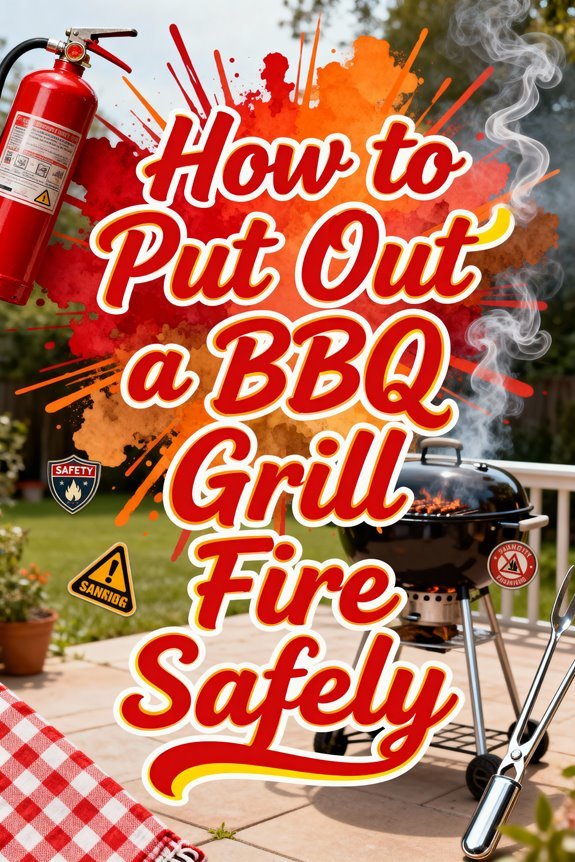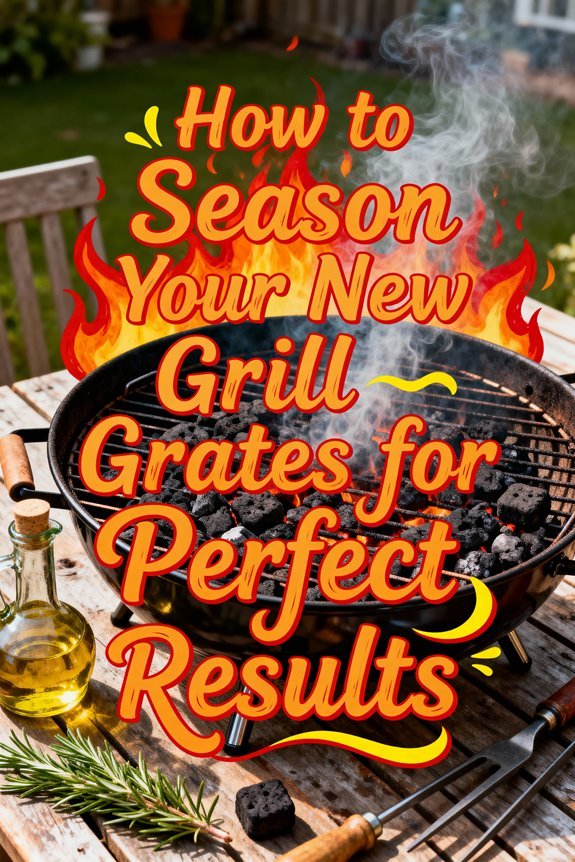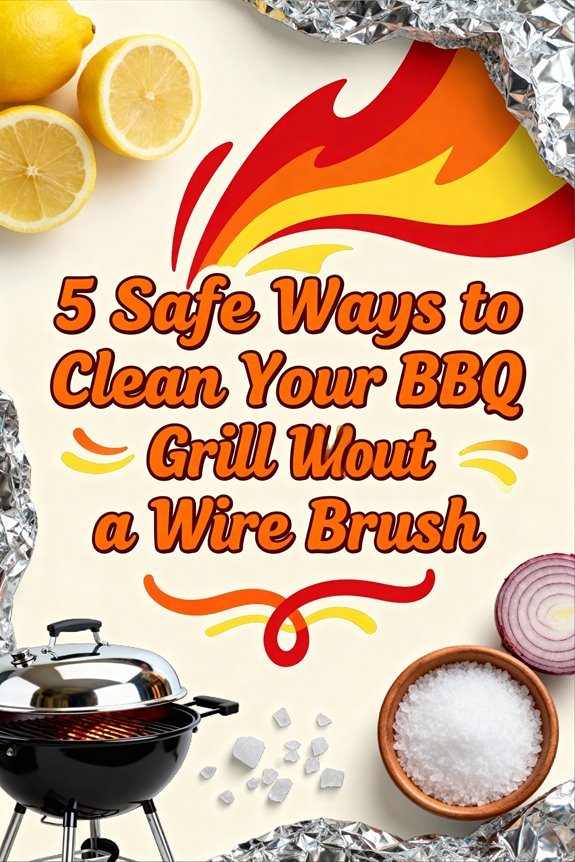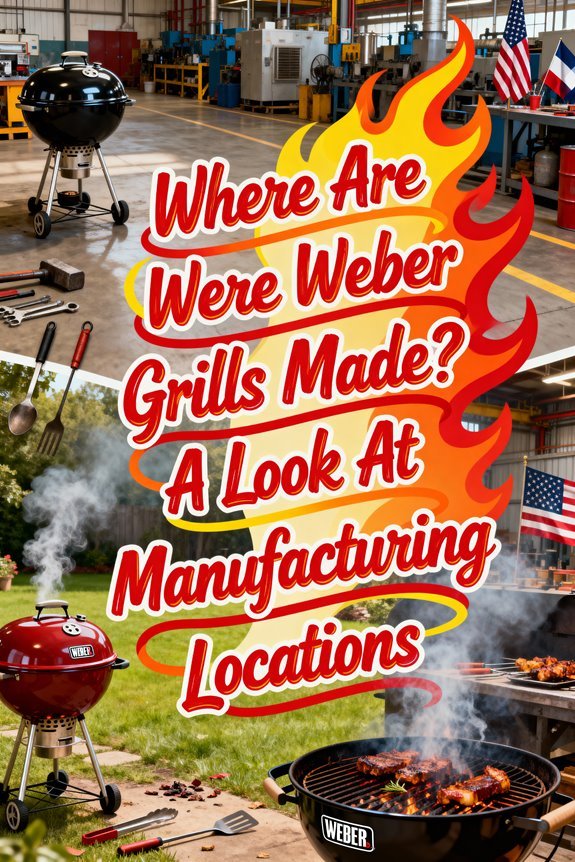If your BBQ grill catches fire, immediately turn off the gas supply by closing the propane valve while maintaining distance with long-handled tools. For small grease fires, smother flames with baking soda—never use water, as it’ll cause dangerous flare-ups. Deploy a Class B fire extinguisher for larger fires, aiming at the base and sweeping side to side. If flames reach the propane tank, evacuate immediately and call emergency services. Understanding proper prevention techniques and emergency protocols will help you maintain control during critical situations.
Immediate Steps to Take When Your Grill Catches Fire
When your grill catches fire, your first priority is protecting yourself and others from harm. Immediately establish a safe perimeter by keeping children and pets at least 3 feet away, ensuring everyone has a clear fire escape route. Turn off the gas supply to stop fuel flow and prevent escalation. Maintain gas control by closing the valve on your propane cylinder if accessible. Remember the lefty loosey rule when disconnecting the propane tank in an emergency. Use long-handled tools to maintain safe distance while managing the situation. Never attempt to extinguish large grease fires with water, as this creates dangerous flare-ups. Keep a fire extinguisher within reach as your primary suppression tool. Don’t leave the grill unattended during this critical period. If flames spread beyond the grill’s contained area, evacuate immediately and call the fire department. For charcoal grills experiencing a fire, close the lid to cut off the oxygen supply. Close all grill vents completely to effectively suffocate the flames by depriving them of oxygen.
Using Baking Soda and Fire Extinguishers Effectively
If your BBQ grill catches fire, baking soda serves as your first line of defense for small grease fires by cutting off the oxygen supply that feeds the flames. Pour it liberally over the fire’s base—insufficient amounts won’t extinguish it. Never confuse baking soda with flour or baking powder, which will worsen grease fires. After application, close the grill lid and vents to deprive flames of oxygen. When handling grilled meats, remember that proper food storage helps prevent dangerous bacterial growth. Regular burner port cleaning helps prevent dangerous flare-ups that could lead to grill fires.
For larger fires, deploy a Class B dry chemical fire extinguisher. Aim at the fire’s base and sweep side to side from a safe distance. Keep fire extinguishers tested, charged, and within reach. If flames involve the propane tank or become uncontrollable, evacuate immediately and call emergency services. Never use water on grease fires.
Once you evacuate, close the door behind you to contain the fire and prevent it from spreading to other areas.
Safe Extinguishing Methods for Charcoal Grills
While emergency fire situations require immediate intervention, charcoal grills demand different extinguishing techniques than gas models due to their sustained heat retention. Close both top and bottom vents completely to eliminate oxygen supply, initiating charcoal cooling through suffocation. You’ll need heat-resistant gloves, metal tongs, and a water-filled bucket for safe handling.
For rapid extinguishment, remove charcoal with tongs and submerge it in water. Alternatively, spray water directly onto coals, though this creates steam hazards. Never cover hot grills immediately—this traps heat and damages components. Much like monitoring a smoker’s temperature gauge when cooking chicken, careful attention to cooling is essential for safety. Maintaining a steady indirect heat zone helps prevent flare-ups during grilling, just as it does when smoking meats.
Proper fire prevention requires patience. Allow 8-12 hours for complete charcoal cooling before disposal. Verify temperature by hovering your gloved hand six inches above the grill. Use a probe to measure temperature, aiming for 60-70°F to confirm the charcoal is safe for handling. Store cooled ash in metal containers, separated from combustible materials, preventing accidental re-ignition.
[affiai keyword=”heat resistant grill gloves and tongs” template=”carousel” count=”3″
Proper Grill Placement to Prevent Fires
Strategic grill placement forms your primary defense against residential fire hazards, requiring precise adherence to clearance specifications before ignition. Maintain minimum 10-foot distances from structural walls and combustible building materials. Position your grill 3 feet from deck railings, overhanging branches, and elevated structures. Establish safety zones on level, stable surfaces away from wooden components and eaves. Regular grill maintenance helps prevent dangerous grease fires that could spread to nearby structures. Constant monitoring is crucial when grilling at high temperatures around 425°F to prevent flare-ups.
You’ll need to verify compliance with NFPA fire codes and local regulations governing grill positioning in residential areas. Prohibit operation on balconies or under overhangs unless explicitly permitted. Clear combustible materials—leaves, branches, debris—from the designated cooking area. Verify adequate separation from children’s play areas and lawn activities. Install equipment exclusively outdoors on non-combustible surfaces, maintaining accessible fire extinguisher proximity. Use grill pads beneath units to prevent heat transfer damage. Consider wind direction and safety when positioning your grill to prevent flames from spreading toward structures or igniting nearby materials.
Essential Grill Maintenance to Reduce Fire Risk
Because grease accumulation represents the primary ignition source in 60% of grill fires, you’ll need to implement systematic maintenance protocols that address critical fire risk components. Execute grill cleaning after each use by scraping grates with a wire brush to eliminate food particles and grease residue. Use warm soapy water and a non-abrasive cloth for thorough surface cleaning. For optimal cleaning results, heat the grill to 400 degrees Fahrenheit to help loosen stubborn residue through steam action. Perform weekly deep cleaning of the interior and grease trap to prevent dangerous buildup. Conduct monthly burner inspection to verify proper airflow and identify blockages that cause flare-ups. Check propane lines and hose connections for wear, cracks, or leaks using soapy water detection methods. Examine the ignition system functionality and replace depleted batteries immediately. Season grates with oil to prevent rust formation. Tighten loose bolts on the grill frame, lid, and structural components to maintain stability and prevent gaps that could allow oxygen to fuel fires. Establish a documented maintenance schedule aligned with seasonal usage patterns to guarantee consistent fire risk mitigation.
Emergency Preparedness for Safe Grilling
Effective grill fire prevention requires establishing thorough emergency protocols before you ignite your first burner. Position your grill at least 10 feet from combustible structures, overhanging branches, and flammable materials. Conduct a thorough grill inspection before each use, checking for gas leaks using a soap-water solution and examining connections for wear. Place your grill on non-combustible surfaces like concrete or asphalt to prevent heat transfer. Similar to smoking chicken drumsticks, maintaining proper cooking temperatures helps prevent dangerous flare-ups while grilling. Always ensure the propane valve is fully closed before making any gas line connections.
Establish a 3-foot safety perimeter to restrict children and pets from the cooking zone. Your fire safety equipment must include a Class B fire extinguisher rated for grease fires and a functional garden hose within immediate reach. Never begin grilling without these essential tools accessible. Store emergency service numbers in your phone, and familiarize yourself with your extinguisher’s operation procedures before emergencies arise. Avoid wearing loose clothing that could ignite from flames or hot surfaces during grilling operations.







